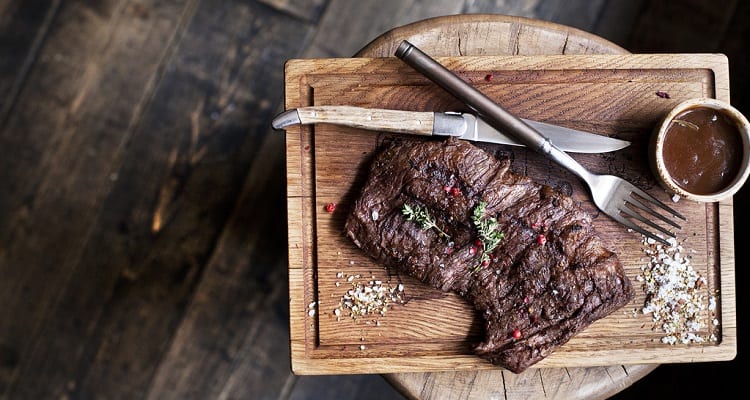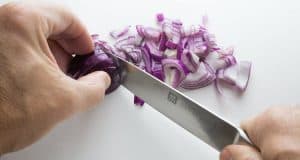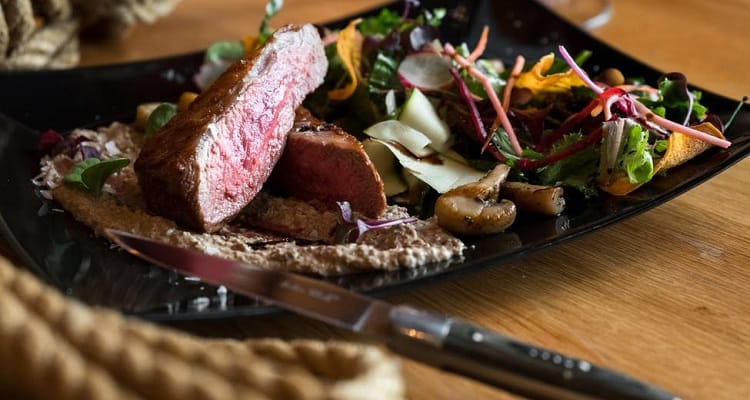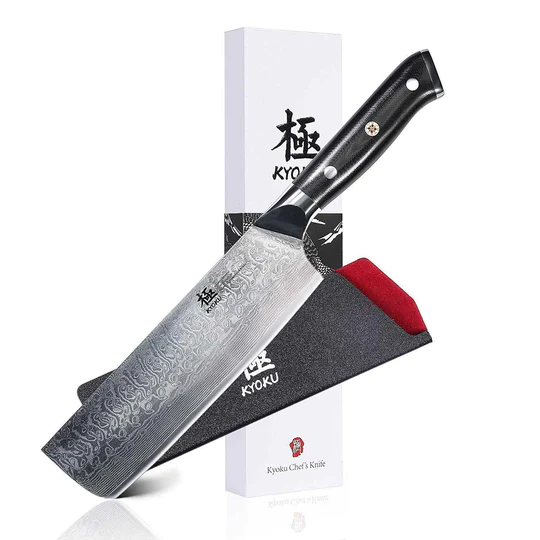


The trick to cutting steak is to have a clean slice without losing too much juice. Cutting a steak with the right knife helps you retain as much juice in each slice of your steak for you to enjoy.
Both options are incredible and would deliver an excellent cut depending on the steak they are dealing with. However, let’s explore both options first to see the option you consider the best.
A Serrated Steak Knife comes with a scalloped edge. These tiny scallops help deliver a clean cut through your steak without removing too much juice from the steak’s interior. The scallops, sometimes referred to as gullets, are the blade’s teeth. The serrated knife works like your regular saw, cutting through the tough steak exterior to deliver clean tiny slices of fine delicious meat.

Traditionally, all steak knives are given serrated edges because professionals understand the ease of a blade’s edge teeth, especially when the edge is designed to deal with juicy or tough exteriors. Serrated knife often comes with impressive edge retention that doesn’t usually require frequent sharpening. However, serrated knives are more difficult to sharpen than a straight blade.
This is because an electric sharpener wouldn’t deliver a great sharpness to the blade. It is better to avoid an electric sharpener for serrated blades. The perfect sharpeners are ceramic sharpeners and whetstones, but they require patience to use. You could also give your serrated knife set to professional sharpeners for thorough sharpening and care.
Furthermore, serrated knives are versatile as they are used for cutting fruits, meats, and hard crust bread such as boules and baguettes. Serrated knives are best with tough food with a hard exterior and wouldn’t be ideal for tender meat or food with a soft interior. In this case, non-serrated, or otherwise known as straight blade knives, are best used for such.
Using the serrated knife on a tender steak will squash the meat and squeeze the juice out of it as you cut through. This might reflect poorly on the taste of the steak.
Unlike the scalloped gullets edge that a serrated knife has, a straight blade knife comes with a razor-sharp edge. This edge could be a double bevel or could have a single bevel. However, they are as great as a serrated knife when it comes to cutting steaks perfectly.

A non-serrated knife is the perfect steak knife to use when you want to get the best cut from your filet mignon, top blade steak, sirloin, and other tender steaks.
Also, unlike the saw-like motion, a serrated knife adopts when cutting through your steak while a straight knife cuts through in one stroke. Thus, it is easier to cut steaks as you get to skip the back and forth sawing style of a serrated knife.
Also, sharpening a straight knife is way easy as it goes with all manners of sharpeners. Electric sharpener, whetstone, ceramic sharpening rod, and other forms of sharpeners would give the edge a razor-sharpness to cut through your steak effortlessly.
Since the edge is straight, the edge uses all its sharpness to go through the steak, resulting in lower edge retention in straight knives. The constant force against the blade’s edge dulls it over time, unlike the serrated knife that comes with hallow glutes, which helps the edges saw through food, barely affecting the edge line.
The straight knife is better at precision cutting as it requires almost no effort to deliver the desired cut while retaining the juice for a better taste. Furthermore, the versatility of a straight knife often depends entirely on how sharp it is. Thus, you might find it difficult to use on tough steak, bread, and fruits. You may be restricted to using it on just tender steaks only.
| Serrated | Straight | |
| Length | 4-5 inches | 4-5 inches |
| Weight | Lightweight | Lightweight |
| Edge | Scalloped | Straight |
| Construction | Hand-forged or Stamped | Hand-forged or Stamped |
| Blade material | Carbon steel, stainless steel, or ceramic | High-carbon steel or Damascus steel |
| Bevel | Single | Double |
Using either the serrated and non-serrated steak knife is a matter of preference and the type of steak at stake. These two types of steak knives are similar and yet so different. Their core differences are highlighted below:
Straight steak knives require frequent maintenance than serrated knives. The edge gets dull faster than the serrated edge, and you might need to sharpen it often. Although, sharpening a straight steak knife is easy and can be done using any sharpener, unlike the serrated knife.
A serrated knife is great with tough steak as it saws through the steak to cut our fine slices without losing much juice. The straight knife is perfect on tender steak and delivers more effortless cutting than the serrated knife. Also, a straight knife gives you control for maneuvering a cleaner cut than a serrated knife.
In terms of versatility, the serrated knife is better as it can be used on bread, fruits, roasts, and other food. Non-serrated or straight knives are more famous for their preference for tender or softer types of meat and food.
If you love your steak soft and juicy, you are better off with a straight blade knife. But if you love your steaks well-done with a spiced and crusty exterior, then a serrated knife is best for a clean cut.

Knife Buzz offers independent product reviews on a wide range of knives used in the kitchen, home, and outdoors. We make it easy for you to find the right knife at the best price.

Knife Buzz offers independent product reviews on a wide range of knives used in the kitchen, home, outdoors and at work.
The Knife Buzz Team are passionate about reviewing knives and we cater to a targeted audience that needs independent advice before purchasing.
KnifeBuzz.com may earn affiliate commissions on some pages of this website. Knife Buzz is a participant in the Amazon Services LLC Associates Program, an affiliate advertising program designed to provide a means for sites to earn advertising fees by advertising and linking to Amazon.com. Amazon and the Amazon logo are trademarks of Amazon.com, Inc, or its affiliates. When you click links to various merchants on this site and make a purchase, this can result in this site earning a commission. Other affiliate programs and affiliations include, but are not limited to, Google AdSense.